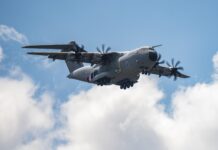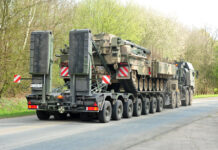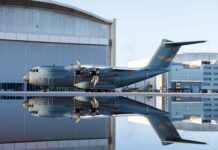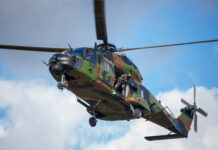We live in an era where much of the conversation surrounding air force happenings is based around future sixth-generation fighters and collaborative combat aircraft (CCA) and what these technologies will mean for the air forces of the future. All of this tends to overshadow critical capabilities and missions in the here and now. Amongst these are the less glamorous, but highly important, issue of transport aircraft, arguably the most widely used, but in many cases under-appreciated, air force asset.
There have been significant developments at the high-end of the transport aircraft spectrum in recent years, with the end of Boeing C-17 production in 2015 a case in point. This was a unique capability that offered its operators the ability to carry large payloads at extended ranges, incredibly useful in both military and humanitarian missions. C-17 users include the US Air Force (USAF), the Royal Air Force (RAF), the Royal Australian Air Force (RAAF), Royal Canadian Air Force (RCAF), Strategic Airlift Capability (SAC) for European NATO, Indian Air Force (IAF), Kuwait Air Force (KAF), Qatar Emiri Air Force (QEAF) and the United Arab Emirates Air Force (UAEAF). In total, 279 C-17s were built, with first delivery to the USAF in 1993. Boeing continues to be contracted to provide sustainment, maintenance and training support to C-17 customers internationally.
The former Soviet Union had developed a full spectrum air transport capability and this was continued, to a lesser extent, by the two main successor states, Russia and Ukraine in the form of Ilyushin and Antonov products respectively. The Ilyushin Il-76 is still in production for the Russian Air Force in the modernised Il-76MD-90 configuration, with the Il-76MD-90AE export variant also available. The Il-76 provides the basis for the Beriev A-50 airborne early warning and control (AEW&C) platform for the Russian Air Force, the Indian A-50E/I with Israeli radar and avionics, and the Chinese KJ-2000 AEW&C system. The Il-76 has a broad international customer base, but since the invasion of Ukraine in 2022, Russia has not been able to export new aircraft or legitimately support existing Il-76 export customers. As for Ukraine and Antonov, sadly it has more pressing concerns at this point than reinvigorating its transport aircraft fleet and production capabilities.
China and Japan
China had previously based its transport aircraft capabilities on locally manufactured aircraft based on Soviet-era technology, such as the Shaanxi Y-8 which was essentially an Antonov An-12 clone, and had then acquired aircraft such as the Il-76 from Russia to meet its needs. However, as in so many other areas of aerospace and defence technology, China has acquired the capability to design, develop and manufacture a range of indigenous transport aircraft solutions.
![The Xi’an Aircraft Industrial Corporation (XAC) Y-20 entered service with the Chinese military in 2016; the aircraft can be considered the Chinese equivalent of the Boeing C-17. A tanker variant is available, while the Y-20 also provides the basis for the new KJ-3000 AEW&C platform. [Cute Orca Weibo Account]](https://euro-sd.com/wp-content/uploads/2025/06/Y-20-China-Kopie-1024x575.jpg)
Arguably the most significant Chinese transport aircraft is the Xi’an Aircraft Industrial Corporation (XAC) Y-20, the first examples entered service in 2016 and the aircraft remains in production. The Y-20 can be considered to be in the same general performance category as the C-17 and will probably replace all Il-76 aircraft in Chinese service. Two variants have also been developed, namely a tanker and the KJ-3000 AEW&C platform that is in flight testing. The Chinese military has a substantial requirement for Y-20 aircraft, but XAC are also looking to achieve export sales, thus far without success.
Another strategic-level transport aircraft looking for export sales is the Kawasaki C-2 from Japan. In the early 2000s, the Japan Air Self-Defense Force (JASDF) developed the C-X requirement to replace its existing Kawasaki C-1 and C-130H transport assets. After evaluating aircraft options from both the US and Europe, Japan decided that the options available were unsuitable and that the C-X requirement could only be met through the development of an indigenous solution. Hence the development of the C-2 to meet the JASDF transport requirement; also in service is the RC-2 ELINT version. Export sales are actively being sought to extend the production run and reduce unit prices.
European solutions
In the early 1980s, European industry began looking into a multinational collaborative effort to develop a new transport aircraft to replace legacy C-130 and C-160 Transall systems; eventually this would result in an industrial grouping covering British, French, German and Italian companies. Later Belgium, Luxembourg and Türkiye would join the programme, although Italy would later withdraw. There was also non-European involvement from Malaysia and South Africa. The overall objective was to build the A400M.
![April 2024, Carcassonne, France: Two Serval armoured vehicles in combat order of the 3e régiment de parachutistes d'infanterie de marine (3e RPIMa) were loaded on to an A400M transport aircraft of 4/61 Béarn transport squadron, Armée de l'air et de l’espace, and ready for take-off in 15 minutes. [Armée de l'air et de l’espace]](https://euro-sd.com/wp-content/uploads/2025/06/Serval-A400M-Kopie-1024x682.jpg)
Although European efforts at the heavier, strategic airlift end of the transport aircraft spectrum have thus far not materialised, lower down the scale European industry has done well in the tactical transport sector. The Leonardo C-27J, built on the strong Italian transport aircraft tradition in the form of the Aeritalia G.222, has been sold to Italy, the US and five other NATO member countries. International customers include Australia, with others in Africa, Central Asia and South America.
![The second Indian Air Force (IAF) Airbus C295 on its delivery flight in April 2024. The IAF has ordered a total of 56 C295 aircraft, with 16 will be built in Spain, and the remaining 40 manufactured and assembled by Tata Advanced Systems Limited (TASL) in India. [Airbus]](https://euro-sd.com/wp-content/uploads/2025/06/C295-Kopie-1024x683.jpg)
Labours of Hercules
In the early 1950s, the USAF looked to acquire a transport aircraft to replace the majority of its World War 2-vintage transport fleet, turning to Lockheed (now Lockheed Martin) for a solution which resulted in the C-130A Hercules. The aircraft made its maiden flight in August 1954 and entered service with the USAF in December 1956, with Australia becoming the first export customer. Since then it has become the definitive Western medium transport aircraft and remains in production to this day.
More than 70 years after its first flight and a little over 68 years since its entry into service, the longevity of the C-130 Hercules cannot be argued with. However, that is not to say that there have been no efforts to develop a C-130 replacement for the US military. There have been programmes for a successor system, but none of these have managed to become a reality. Instead avionic and structural upgrade programmes emerged to extend the service life of legacy Hercules aircraft, and then, a new Hercules variant emerged in the 1990s, the C-130J.
The RAF was the first to place an order for the C-130J in December 1994 comprising 10 standard C-130J and 15 larger C-130J-30 Hercules aircraft, with first deliveries in 1998. The decision to order the C-130J was driven by the existing C-130K transport fleet reaching the end of its service life and significant delays in the A400M programme, which was the original nominated RAF C-130 replacement. In comparison to its C-130H predecessor, the C-130J featured advanced avionics, new engines and propellers, which, amongst other things, delivered increased operational range and speed. The RAF was one of the first to retire the C-130J, with the Hercules fleet withdrawn from service at the end June 2023, following the arrival of the A400M. The first RAF C-130 had arrived in the UK in December 1966, meaning that the various C-130 models had achieved over 56 years of service with the RAF.
![A Lockheed Martin C-130J Hercules of 41st Airlift Squadron, USAF conducts a training mission over Alaska. The Hercules has been the dominant Western medium transport aircraft since the C-130A entered service in 1956. [USAF]](https://euro-sd.com/wp-content/uploads/2025/06/C-130J-Kopie-1024x681.jpg)
New ways of thinking
The Brazilian Air Force (Força Aérea Brasileira or FAB) was a long-term C-130 operator, receiving its first C-130E aircraft in August 1964; in total, 11 C-130E/SC-130E aircraft were acquired by June 1969. Then, between April 1975 and March 1987, the FAB acquired eight C-130H aircraft from Lockheed Martin, and acquired ten ex-Italian Air Force (AMI) C-130H in addition from November 2011. In total, the FAB would run a fleet of 29 C-130 aircraft, used for transport, search and rescue (SAR), reconnaissance, tanker and firefighting missions. A number of FAB C-130s were put through the Avionics Upgrade Programme (AUP) to increase performance and extend operational life.
Post-2000, the FAB starting thinking about a replacement for its C-130 fleet, the majority of which were rapidly approaching the end of effective service life. At much the same time, Brazilian aerospace manufacturer Embraer was looking to expand its product range and became interested in the possibilities offered by the development of an advanced medium transport aircraft, essentially a C-130 equivalent platform. Thus FAB had the requirement and Embraer was working towards a clean-sheet design to meet a C-130 class transport aircraft requirement. Furthermore, subsequent market analysis revealed that there was significant international interest in a modern medium transport aircraft.
In 2009, the Brazilian government signed a development contract for what became known as the C-390; this also covered the manufacture of two prototype aircraft. In 2014, the FAB officially signed up the C-390 aircraft and the first C-390 would be delivered to the FAB in 2019, allowing them to start retiring their C-130 fleet. The first export customer was Portugal, ordering five C-390 in 2019 to replace their C-130 fleet. Since then, six other NATO members (Czechia, Hungary, Lithuania, The Netherlands, Slovakia and Sweden) have either received, ordered or are in the process of negotiating to acquire the aircraft. Other export customers include Austria, the Republic of Korea and an ‘undisclosed international customer.’
![The Brazilian Air Force (Força Aérea Brasileira or FAB) looked for a successor to its C-130 transport aircraft fleet that was more advanced and offered a multi-mission capability. This led to the development of the Embraer C-390 now in FAB service and also in service with or on order for nine export customers. [FAB]](https://euro-sd.com/wp-content/uploads/2025/06/KC-390-June-2024-Kopie-1024x696.jpg)
To meet speed and range requirements, the C-390 is equipped with two International Aero Engines (IAE) V2500-E5 turbofans each producing 137.895 kN of thrust. According to IAE, the V2500-E5 is based on the V2500-A5 engine and nacelle which has over 275 million flight hours. The V2500 engine family is used on the extremely successful Airbus A319, A320 and A321 commercial aircraft; as a result, a fully established global MRO/service network to support the engine is available.
Initially the FAB called for the C-390 to fulfil the transport mission, but also to provide an SAR and firefighting capability. To this was added the air tanker mission (KC-390) with the FAB and Embraer more recently working towards an intelligence, surveillance and reconnaissance (ISR) variant and a possible maritime patrol capability for the C-390. Further evidence of C-390 mission flexibility comes from the Hungarian Air Force whose C-390s can be equipped with a ‘roll-on/roll-off’ medical care module to provide an intensive care capability. Elsewhere, the Portuguese Air Force is interested in a ‘roll-on/roll-off’ ISR module for its C-390s.
For the majority of air forces, it is the tactical and medium transport aircraft categories that continue to be of most interest. In the tactical sector, European manufacturers have a number of credible solutions to offer. In the medium sector, the C-130 Hercules has been the dominant platform for a considerable time and the C-130J continues the Hercules history. However, a serious competitor has emerged from Brazil in the form of the Embraer C-390, providing air forces with a medium transport aircraft requirement with a credible alternative solution.
David Saw



![Y-20 China Kopie The Xi’an Aircraft Industrial Corporation (XAC) Y-20 entered service with the Chinese military in 2016; the aircraft can be considered the Chinese equivalent of the Boeing C-17. A tanker variant is available, while the Y-20 also provides the basis for the new KJ-3000 AEW&C platform. [Cute Orca Weibo Account]](https://euro-sd.com/wp-content/uploads/2025/06/Y-20-China-Kopie.jpg)



![Europe’s airlift rejuvenation: is it enough? An Airbus A400M in French service, pictured on 25 June 2024. As things stand there will ultimately be 170 A400Ms in service with European air forces. [Armée de l'Air et de l'Espace]](https://euro-sd.com/wp-content/uploads/2025/06/French-A400M-Armee-de-lAir-et-de-lEspace-Kopie-218x150.jpg)





